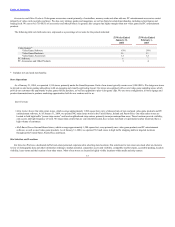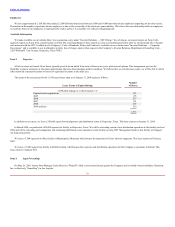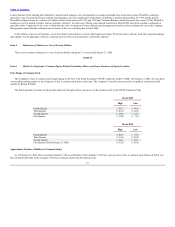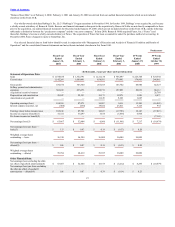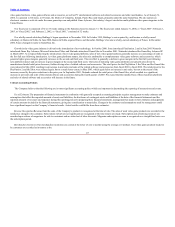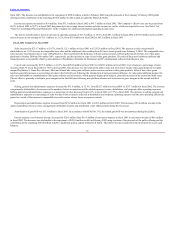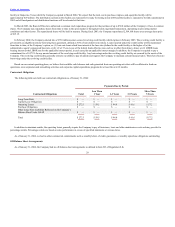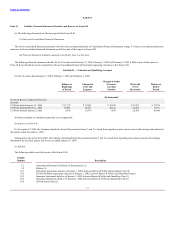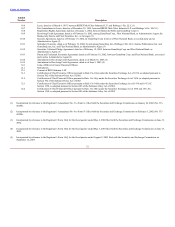GameStop 2003 Annual Report Download - page 32
Download and view the complete annual report
Please find page 32 of the 2003 GameStop annual report below. You can navigate through the pages in the report by either clicking on the pages listed below, or by using the keyword search tool below to find specific information within the annual report.
Table of Contents
video game hardware, video game software and accessories, as well as PC entertainment software and related accessories and other merchandise. As of January 31,
2004, we operated 1,514 stores, in 49 states, the District of Columbia, Ireland, Puerto Rico and Guam, primarily under the name GameStop. We also operate an
electronic commerce web site under the name gamestop.com and publish Game Informer, the industry’s largest circulation multi-platform video game magazine in the
United States.
Our fiscal year is composed of 52 or 53 weeks ending on the Saturday closest to January 31. The fiscal years ended January 31, 2004, or “fiscal 2003”, February 1,
2003, or “fiscal 2002,” and February 2, 2002, or “fiscal 2001,” consisted of 52 weeks.
Our wholly-owned subsidiary Babbage’s began operations in November 1996. In October 1999, Babbage’s was acquired by, and became a wholly-owned
subsidiary of, Barnes & Noble. In June 2000, Barnes & Noble acquired Funco and thereafter, Babbage’s became a wholly-owned subsidiary of Funco. In December
2000, Funco changed its name to GameStop, Inc.
Growth in the video game industry is driven by the introduction of new technology. In October 2000, Sony introduced PlayStation 2 and in June 2001 Nintendo
introduced Game Boy Advance. Microsoft introduced Xbox and Nintendo introduced GameCube in November 2001. Nintendo introduced the Game Boy Advance SP
in March 2003. As is typical following the introduction of new video game platforms, sales of new video game hardware generally increase as a percentage of sales in
the first full year following introduction. As video game platforms mature, the sales mix attributable to complementary video game software and accessories, which
generate higher gross margins, generally increases in the second and third years. The net effect is generally a decline in gross margins in the first full year following
new platform releases and an increase in gross margins in the second and third years. Unit sales of maturing video game platforms are typically also driven by
manufacturer-funded retail price decreases, further driving sales of related software and accessories. The retail prices for the PlayStation 2, the Xbox and the GameCube
were reduced in May 2002, resulting in an increase in unit sales and sales of the related software and accessories from fiscal 2001 to fiscal 2002. The retail prices for the
PlayStation 2 and the Xbox were reduced again, but to a much lesser extent, in May 2003, which again led to an increase in unit sales, but not to the extent of the
increases caused by the price reductions in the prior year. In September 2003, Nintendo reduced the retail price of the GameCube, which resulted in a significant
increase in unit sales and sales of the related software and accessories during the fourth quarter of 2003. We expect that the installed base of these hardware platforms
and sales of related software and accessories will increase in the future.
Critical Accounting Policies
The Company believes that the following are its most significant accounting polices which are important in determining the reporting of transactions and events.
Use of Estimates.The preparation of financial statements in conformity with generally accepted accounting principles requires management to make estimates and
assumptions that affect the reported amounts of assets and liabilities, the disclosure of contingent assets and liabilities at the date of the financial statements and the
reported amounts of revenues and expenses during the reporting period. In preparing these financial statements, management has made its best estimates and judgments
of certain amounts included in the financial statements, giving due consideration to materiality. Changes in the estimates and assumptions used by management could
have significant impact on the Company’s financial results. Actual results could differ from those estimates.
Revenue Recognition.Revenue from the sales of the Company’s products is recognized at the time of sale. The sales of used video game products are recorded at the
retail price charged to the customer. Sales returns (which are not significant) are recognized at the time returns are made. Subscription and advertising revenues are
recorded upon release of magazines for sale to consumers and are stated net of sales discounts. Magazine subscription revenue is recognized on a straight-line basis over
the subscription period.
Merchandise Inventories.Our merchandise inventories are carried at the lower of cost or market using the average cost method. Used video game products traded in
by customers are recorded as inventory at the
23


